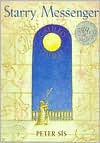Reading Group Guide
Peter Sís's picture book biography of Galileo offers readers not only the story of Galileo's life but also a study of courage and conviction, insight into the development of science, a look into history, and an extraordinary example of how art and text can combine to communicate information. The book can be read on many levels. In grades 4–6, teachers can find connections to history, science, art, literature, writing, and a catalyst for a wide variety of research projects.
1. In the opening pages of Starry Messenger Peter Sís shows the names of several men on a time line: Eudoxus, Aristotle, Ptolemy, Aristarchus, Archimedes, and Copernicus. Discuss with your students what sources they would use to find out more about these men. They could include nonfiction books about these men, astronomy, and the ancient world; the encyclopedia; the Internet; etc. Develop the idea that since nonfiction books do not have to be read from cover to cover or necessarily in the order that the chapters are written, they should consider any book that they think might have some useful information. Talk about what questions your students would want to answer. For example: Were these men scientists or philosophers? What discoveries did they make? What is their connection to Galileo? Ask your students to write down any information they find fascinating. Your children can write reports, give oral and visual presentations, or present their research in the same manner Peter Sís uses in Starry Messenger. Have them write a basic story about their subject, illustrate it, and then fill the margins with the interesting information they gathered in their research.
2. Do your students know that in the same yearnthat Galileo was writing The Starry Messenger, the
British were settling the Jamestown Colony, or that when Galileo was giving lectures on comets, the first African slaves were brought to Virginia? Put Galileo in the context of what was happening in other countries of the world at the same time.Using events noted in the book and from other sources, create a time line. Place the life of Galileo above the line and events that occurred around the world below it.
3. In the year of Galileo's birth, 1564, Italy was not like it is today. It was a compilation of city-states. Using information provided in Starry Messenger and other sources, discuss the meaning of the citystate. Where was Pisa located? On a large outline map, locate and label each city-state. Make a chart that shows the city-state, the type of government it had, and what each called its ruler. Compare these systems to present-day governments. How is our country ruled? Are there countries that are still ruled as monarchies? How do these systems affect the lives of the people?
4. Galileo looked through his telescope and wrote down everything he observed. Encourage your students to be good observers. Remind them that you observe the world with all of your senses. Open the classroom door and a window in the room. Have the class sit quietly for a few minutes and then write down and describe all of the things they observe (hear, see, smell, feel, and taste). Make a chart and compare the results. Did they use all of their senses? Which sense did they use most? They should decide if they were good observers.
5. Peter Sís quotes a line from William Shakespeare on the page announcing the birth of Galileo: "Be not afraid of greatness: some are born great, some achieve greatness, and some have greatness thrust upon them." Have your students look carefully at the picture of all the babies sharing a nursery with Galileo. It is easy to pick him out – perhaps Peter Sís is telling us that Galileo is one who was born great. The students should look carefully at the blankets in which the babies are wrapped. Each one's future profession is pictured. Have your students identify as many of the professions as they can. They can speculate and discuss which babies will achieve greatness in those professions and which might have greatness thrust upon them. Then ask the children to draw their self-portraits as babies or bring in their own baby photographs. Each picture should include a caption indicating what the baby's future profession may be. Then put all the photos/drawings together to form your own class nursery picture.
6. Galileo was a man of principle. He chose to be under house arrest for the rest of his life rather than deny his belief in the Copernican system that the earth revolved around the sun and the earth was not the center of the universe. Have the class pretend that Galileo time-warped from the past into their classroom. They will have an exclusive interview with him before he goes back in time. What questions would they ask him? Divide the class into small groups. Have the children brainstorm and formulate questions and answers based on what they have read. Have each group write a script and perform a mock interview of Galileo in the manner of "Meet the Press."



